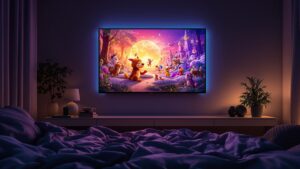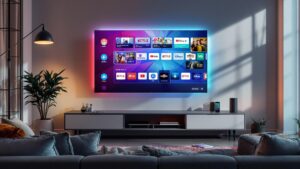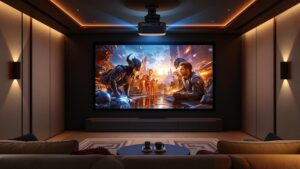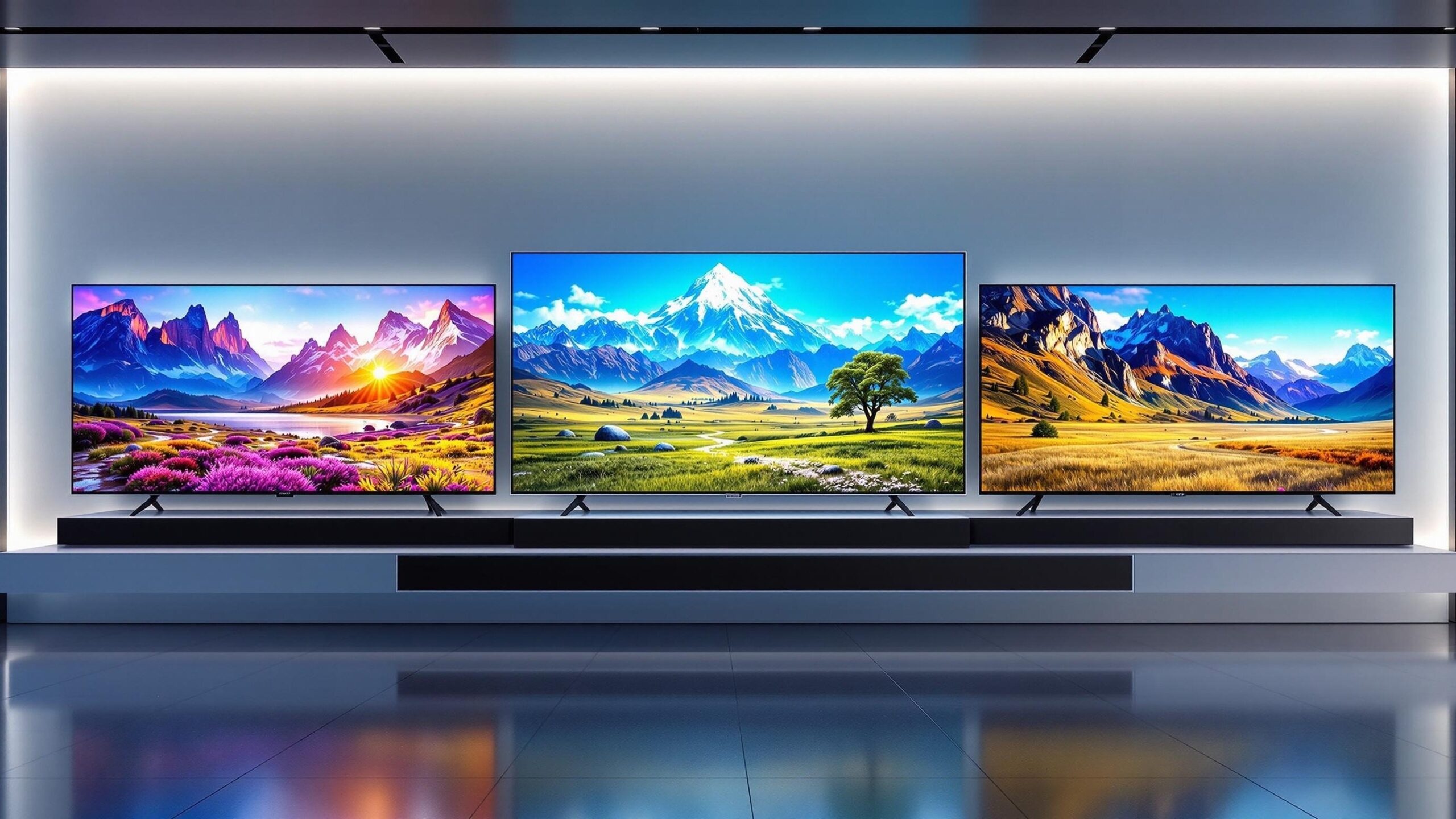TV Types and Formats: Exploring the Exciting World of Modern Television Technology
Television is no longer just a box in the corner of the living room—it’s a portal to immersive entertainment, a centerpiece of smart home setups, and a canvas for cutting-edge visuals. As technology races ahead, the world of TVs has expanded into a dazzling variety of types and formats, each promising something new and thrilling. From classic LED displays to futuristic rollable OLEDs, the choices can feel endless. This page explores everything you need to know about modern TV types and formats, giving you a complete picture of how televisions have evolved, what they offer, and how to choose the perfect one for your space and lifestyle.

OLED TV’s
Welcome to the stunning world of OLED TVs, where picture quality meets pure magic. If you’ve ever dreamed of watching your favorite movies or shows with cinema-level color, infinite contrast, and razor-sharp clarity, OLED delivers on every pixel. These cutting-edge televisions bring each scene to life with breathtaking depth, true blacks, and dazzling highlights—thanks to a revolutionary technology where every pixel lights up independently. It’s not just about watching content

QLED TV’s
Step into the dazzling world of QLED TVs, where cutting-edge technology meets cinematic brilliance. Whether you’re a die-hard movie buff, an intense gamer, or just love binging your favorite shows in jaw-dropping detail, QLED TVs offer a visual experience that’s hard to beat. With quantum dot technology, these televisions deliver vibrant colors, crisp contrast, and incredible brightness that transforms your living room into a full-fledged home theater. From sleek designs

LED/LCD TV’s
Welcome to the bright and versatile world of LED/LCD TVs, the true workhorses of home entertainment. Whether you’re upgrading your setup or diving into your very first flat-screen experience, LED/LCD TVs offer an unbeatable mix of clarity, efficiency, and affordability. From sports fans craving smooth motion to binge-watchers looking for consistent quality, these TVs have earned their place in living rooms around the globe. Backed by decades of innovation, today’s

4K TV’s
Get ready to experience television like never before with the stunning clarity and detail of 4K TVs. Offering four times the resolution of Full HD, 4K televisions bring your favorite movies, shows, sports, and games to life with razor-sharp visuals and breathtaking color. Whether you’re immersed in the latest blockbuster or scanning the field during a game-winning play, every frame bursts with crispness and realism that pulls you into the

8K TV’s
Welcome to the next frontier of home entertainment—8K TVs, where resolution reaches a level of clarity and depth that feels almost unreal. With over 33 million pixels packed into a single screen, 8K TVs offer visuals so detailed and immersive that you can see textures, reflections, and nuances you never noticed before. Whether you’re watching a sweeping cinematic landscape or zooming in on the tiniest elements of a nature documentary,

Smart TV’s
Step into the future of home entertainment with Smart TVs, where streaming, voice control, and next-gen features come together in one powerful screen. Gone are the days of switching between devices and juggling remotes—Smart TVs make it effortless to access your favorite shows, movies, music, and apps all in one place. Whether you’re binge-watching a new series, casting content from your phone, or asking your TV about the weather, the

Projector TV’s
Bring the magic of the big screen into your own home with Projector TVs, where cinematic scale meets immersive clarity. Whether you’re watching your favorite blockbuster, gaming with friends, or enjoying a backyard movie night, projector TVs transform any wall into an epic entertainment experience. With screen sizes that can stretch beyond 120 inches, they deliver unmatched scale and flexibility that no standard TV can replicate. From compact portable models

Portable and Travel TV’s
Entertainment on the go has never been easier or more fun with Portable and Travel TVs. Whether you’re camping in the wilderness, tailgating at the big game, or taking a road trip across the country, these compact TVs bring your favorite shows and movies wherever you are. With lightweight designs, long-lasting batteries, and built-in antennas or streaming apps, they’re designed to deliver high-quality entertainment in even the most remote locations.
The Evolution of Television: From Tubes to Titans
Once upon a time, TVs were clunky cathode-ray tube boxes that offered grainy black-and-white images and a limited number of channels. But technology moves fast. The transition from analog to digital television marked a pivotal point. The flat-screen revolution introduced plasma and LCD panels, leading us into a new age of thinner, lighter, and clearer displays.
Today’s televisions are lightyears beyond their ancestors. With resolutions that rival human vision, ultra-thin panels, voice assistants, and streaming platforms baked in, modern TVs are as much about experience as they are about watching. Formats like 4K and 8K enhance the visuals, while display types like OLED, QLED, and MicroLED push the boundaries of brightness, contrast, and color.
LED and LCD TVs: The Standard Bearers of Modern Viewing
LED and LCD TVs dominate store shelves and living rooms around the world. LCD, or Liquid Crystal Display, uses a backlight to illuminate pixels, delivering clear images at an affordable price. LED TVs are actually a type of LCD, but instead of traditional fluorescent backlighting, they use energy-efficient light-emitting diodes. These TVs are known for their wide availability, cost-effectiveness, and consistent performance. They’re great for brightly lit rooms and are available in a wide range of sizes. However, their contrast ratios and black levels don’t quite match the deeper performance of newer display types like OLED. LED TVs also come in several variations, including Edge-lit and Full-array backlighting. Full-array models offer better contrast control thanks to local dimming zones, making them an appealing option for more discerning viewers.
OLED TVs: Stunning Blacks and Superior Contrast
OLED, or Organic Light-Emitting Diode, represents a leap forward in picture quality. Unlike LED TVs, OLED panels don’t require a backlight. Each pixel emits its own light and can turn off completely to produce perfect blacks. This self-emissive technology results in incredible contrast ratios and vivid colors that seem to pop right off the screen. OLED TVs are known for their ultra-thin designs, wide viewing angles, and cinematic performance. They’re perfect for dark room viewing and offer an immersive experience for movies, shows, and gaming. However, they can be more expensive and are sometimes prone to image retention or burn-in, especially when static images are displayed for long periods. Despite these concerns, OLED has become a favorite among videophiles and design enthusiasts alike. Brands like LG, Sony, and Panasonic have pushed the boundaries of what OLED can do, including creating foldable and rollable screens.
QLED and Neo QLED: Quantum Leap in Brightness and Color
QLED stands for Quantum-dot Light Emitting Diode, and it’s Samsung’s answer to OLED. Rather than using organic compounds, QLED TVs use quantum dots—tiny particles that emit specific colors when exposed to light. The result is an incredibly bright, vibrant picture with a broad color spectrum. QLED TVs are great for bright rooms, offering exceptional performance in daytime viewing and sports watching. They can also reach higher brightness levels than OLED, making them excellent for HDR content. Neo QLED, a newer evolution of QLED, uses Mini LED backlighting for improved contrast, precision, and depth. These televisions combine the reliability of LED technology with the richness of quantum dot color. They’re durable, energy-efficient, and are often packed with advanced features like AI upscaling and anti-reflective coatings.
MicroLED: The Future of Display Technology
MicroLED is the next frontier in television innovation. This cutting-edge technology combines the self-emissive power of OLED with the brightness and durability of LED. Each pixel in a MicroLED screen is an individual micro-scale LED, capable of producing its own light and color. MicroLED TVs offer perfect blacks, incredible brightness, and virtually no risk of burn-in. They also promise long lifespans and modular design, allowing for customizable screen sizes. While still extremely expensive and not widely available, MicroLED is poised to redefine high-end home viewing in the coming years. Manufacturers like Samsung are leading the charge with modular displays that can be built to any size. Though currently limited to luxury buyers, the potential of MicroLED to become mainstream is growing as production techniques evolve.
4K and 8K Resolutions: Enter the Era of Ultra Clarity
Resolution plays a massive role in picture quality. 4K TVs, also known as Ultra High Definition (UHD), offer four times the pixels of Full HD. This means sharper details, smoother edges, and more immersive visuals. 4K is now the standard for new TVs and streaming content, with services like Netflix, Disney+, and Amazon Prime Video offering a growing library of 4K material.
8K takes this even further, boasting four times the pixels of 4K—and a whopping sixteen times more than HD. The result is an ultra-detailed image that looks stunning even on massive screens. However, 8K content is still limited, and the benefits are most noticeable on screens larger than 65 inches. For most users, 4K strikes the perfect balance between resolution, availability, and price. But for those looking to future-proof their setup, or who want the very best visual fidelity, 8K is an exciting glimpse into what’s next.
HDR Formats: Lighting Up the Screen with Realism
High Dynamic Range (HDR) is one of the most transformative technologies in modern TVs. While resolution increases pixel count, HDR enhances each pixel’s performance—making highlights brighter, shadows deeper, and colors more lifelike. There are several HDR formats, including HDR10, HDR10+, Dolby Vision, and HLG (Hybrid Log Gamma). HDR10 is the most common, supported by nearly all modern TVs and streaming platforms. Dolby Vision takes things up a notch by offering dynamic metadata, adjusting brightness and contrast scene by scene. The difference between SDR and HDR is immediately noticeable, especially when watching visually rich content like nature documentaries, fantasy films, or action-packed blockbusters. HDR adds a sense of depth and realism that traditional TVs simply can’t match.
Smart TVs: Where Streaming Meets Simplicity
Today’s TVs do more than just show broadcasts—they’re full-fledged media hubs. Smart TVs come with built-in internet connectivity and operating systems that allow users to stream content, browse the web, play games, and even control smart home devices. Popular smart TV platforms include Android TV, Roku TV, Tizen (Samsung), and webOS (LG). Each offers access to a wide range of apps, from Netflix and Hulu to YouTube and Spotify. Many smart TVs also feature voice control, integration with virtual assistants, and advanced search features that make finding content easier than ever. This integration eliminates the need for external streaming boxes and cables. It brings a clean, seamless experience that’s ideal for cord-cutters, binge-watchers, and tech-savvy households.
TV Screen Sizes and Aspect Ratios: Fitting Your Space and Style
When it comes to choosing a TV, size matters—but not in the way you might think. Bigger screens aren’t always better. The ideal size depends on your room dimensions, seating distance, and personal preferences. While 55 and 65 inches are the most popular sizes today, TVs range from compact 32-inch models to jaw-dropping 100-inch home theater beasts. Aspect ratio also plays a role. Most modern TVs use a 16:9 aspect ratio, which is well-suited for most content. Ultra-wide aspect ratios like 21:9 are emerging for cinematic experiences, though they’re still relatively rare in consumer TVs. Choosing the right size and ratio ensures a comfortable and immersive viewing experience. It also ensures your new TV complements your space rather than overpowering it.
Curved vs. Flat TVs: A Matter of Perspective
Curved TVs promised to revolutionize immersion by mimicking the curve of the human eye. They claim to offer better viewing angles and a wraparound effect that pulls viewers deeper into the action. While the effect is noticeable when sitting directly in front of the screen, it diminishes off-center and can introduce glare issues in brightly lit rooms. Flat TVs remain the standard, offering consistent image quality across angles and better wall-mount compatibility. Most consumers now favor flat models for their practicality, and manufacturers have largely shifted away from curved screens outside of niche markets. That said, curved displays are still popular in gaming monitors and some premium home setups. The debate comes down to aesthetics and viewing preference rather than any massive leap in performance.
Frameless, Rollable, and Transparent TVs: Design Meets Innovation
TVs are no longer confined to the standard rectangle on a wall. Design-forward options are changing how we think about displays altogether. Frameless TVs offer edge-to-edge viewing and sleek minimalism. Rollable TVs like LG’s signature model rise out of a cabinet and disappear when not in use—an engineering marvel that combines function with flair. Transparent TVs are perhaps the most futuristic of all. These displays blend into the background, only becoming visible when turned on. Perfect for high-end installations or businesses, transparent displays offer a peek into what’s possible when design and technology merge. As living spaces become more open and integrated, these design innovations give homeowners greater flexibility without sacrificing style or performance.
Gaming TVs: Built for Speed, Performance, and Immersion
The gaming world has reshaped the TV market. Today’s best TVs offer ultra-low input lag, high refresh rates, and support for technologies like Variable Refresh Rate (VRR) and Auto Low Latency Mode (ALLM). These features ensure buttery-smooth visuals and lightning-fast response times. HDMI 2.1 is a critical spec for next-gen console gamers, enabling 4K at 120Hz and advanced gaming features. OLEDs are popular among gamers for their fast pixel response, while QLED and Mini LED TVs offer brighter performance in well-lit gaming environments. As cloud gaming and game streaming services grow, TVs will continue to evolve into full-fledged gaming hubs, making them even more central to entertainment ecosystems.
Embracing the Infinite Possibilities of Modern TV
TVs have evolved far beyond their original role. They are now intelligent, interactive, beautifully designed, and endlessly customizable. Whether you’re a movie buff chasing perfect blacks, a gamer demanding precision, or a design enthusiast looking for a floating masterpiece, there’s a TV type and format tailored just for you. Understanding the landscape—from LED and OLED to 4K and 8K, from flat to frameless—opens up a world of exciting possibilities. With every passing year, television technology continues to innovate, bringing viewers closer to the action, the story, and the magic. In this golden era of visual entertainment, the real challenge isn’t finding a great TV—it’s choosing the right one for your unique vision of the perfect viewing experience.

